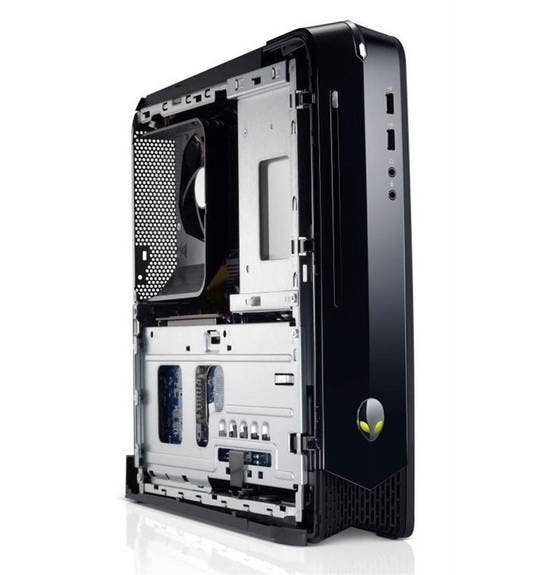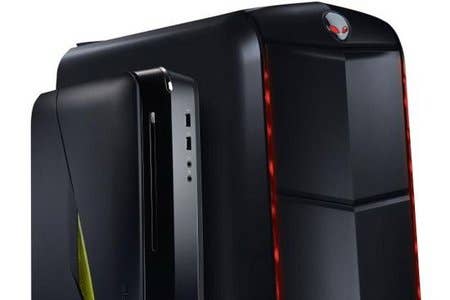Alienware's X51: PC Gaming Invades the Living Room
Digital Foundry on why PC tech is destined for your lounge
Alienware's recently released X51 PC-in-a-console shell is something of a remarkable product. This is the company's cheapest PC to date, and it's aimed 100 per cent at the aspirational core gamer perhaps frustrated by the current lack of a next-gen successor to the Xbox 360 or PlayStation 3. The fact that Alienware is wholly owned by Dell is telling too - this may well be a niche brand, but it's backed by one of the most prolific PC constructors in the world who clearly believes that the PC has a role to the play in the living room.
"Alienware's X51 packs PC power into a console form-factor, and in the flesh it's a remarkable product."
The make-up of the device is ingenious. Alienware is touting the machine as possessing a console form-factor, while retaining the upgradability that offers so many advantages to the PC owners. It's a claim that's been made before and often comes undone through simple scrutiny of the final product, but the fact is that Alienware has delivered: CPU, RAM, optical drive, hard drive and graphics card are a doddle to upgrade in this innovative design.


The mainboard is kept small through the implementation of the mini-ITX specification, while the company has been able to utilise full-size, full-power CPUs owing to the 32nm fabrication process used by Intel - these chips are able to run very cool indeed. The top-spec X51 features a quad core CPU clocked at 3.4GHz, and dissipates heat nicely. There's even room for a dual slot GPU: the NVIDIA GT 545 and GTX 555 are the two options available - not our first choices but they get the job done. The graphics card is housed in its own enclosure at the base of the case, hooked up to the motherboard via a right-angled PCI Express riser card.
There have been small form-factor PCs before the X51 of course: HP's Pavilion Slimlines are excellent examples of shrunken computers that offer remarkable levels of power in console-style cases. However, while state-of-the-art quad core CPUs have been utilised in these pint-sized PCs, there's never been the room, the heat dissipation or the raw power to run a graphics card with anything other than middling gaming potential. Taiwan-based manufacturer Shuttle has got closer with its toaster-sized PCs, but they've never made a challenge for the mainstream like Alienware's console-inspired product.
Of course, in a package like this there are compromises, but ironically it's not the form factor that is wholly to blame. The X51 has an external power supply, available in 240w and 330w incarnations, depending on the graphics card you choose to buy. There's a 160w power budget afforded to the graphics card with the larger power brick, which limits GPU choices. That said, in its review The Verge managed to run a more powerful GTX 560ti in its unit with no issues and alongside AMD's HD 6870, this is probably the best "bang for the buck" graphics card on the market at the moment. Doubtless, X51 enthusiasts will be testing out their units with newer GPU technologies as they come along.
In terms of stock performance, we found that a GTX 555 equipped X51 managed to acquit itself well at 1080p across a range of demanding games from Battlefield 3, Rage and Skyrim to Crysis 2 and StarCraft 2. While the 1080p60 dream proved elusive at max settings on all but Rage, the beauty of PC ownership is of course the ability to change the game's rendering set-up to suit your own needs. Choose your own resolution or shoot for the highest frame-rates, the choice is entirely down to the user. As it is, dropping down to the HD ready 1366x768 resolution used by so-called "HD Ready" screens saw the Alienware machine hit 60FPS with whatever we could throw at it.
So why does the X51 work as a product? In the here and now, can PCs transition across from the bedroom, office or study into the living room? Well, for some time now, they've already been finding a home there: the phenomenon of the HTPC (home theatre PC) sees enthusiasts bringing together their media - music, movies, DVDs, Blu-rays and photos - into one unit attached to the screen. Microsoft encourages and supports this by including a Media Centre front-end within Windows 7 and homebrew alternatives like XBMC do an even better job. However, so-called net-tops based on the Intel Atom architecture (Acer's R3700 is a particular favourite) have proven to be the favourites here, and while the NVIDIA ION2 chipset in this unit can run some games, they'd need to be rather old ones to operate at anything like acceptable frame-rates.
A machine like the X51 fulfils all of these functions and doesn't just match the capabilities of the Xbox 360 and PS3 (both of which are also vying for position as media devices) but provides an enormous improvement. Skyrim looks nice on the consoles, but once you've dialled down anti-aliasing settings, the X51 can run it on ultra settings with the high res texture pack installed at 1080p, 60 frames per section. There's no competition.
Even at 720p60 with max settings engaged, PC gameplay is significantly improved. Alan Wake and Kingdoms of Amalur: Reckoning are two examples I've looked at recently where the faster frame-rates and superior effects tangibly improve gameplay. With Remedy's game we see an example of an engine held back by the console architecture that hosted it, liberated in the transition to PC. Kingdoms of Amalur has clearly been built from the ground up as a console-focused action RPG, and yet it's only on PC that you get 60FPS, that the stylised visuals reach the height of their potential. A jump to 60Hz also means that controller response is that much crisper too.









